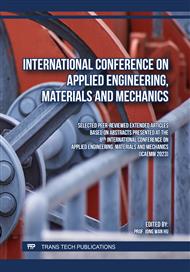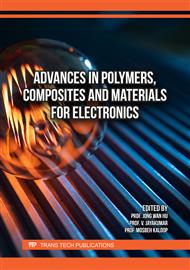p.73
p.83
p.91
p.101
p.109
p.121
p.131
p.139
p.147
Fabrication of Paper-Based Silver Nanoparticle (AgNP) Sensors for Smartphone-Based Colorimetric Detection of Cu (II) in Water
Abstract:
Detection of heavy metals in water has long been a key area of study due to the adverse health effects these substances may bring. Multiple methods of detecting heavy metals have already been established. Though these methods are highly selective and can detect heavy metals in trace amounts, they commonly require specialized equipment. Thus, producing an inexpensive, reliable, and convenient sensor that could be used for point-of-need applications is of great interest. This study focuses on fabricating paper-based silver nanoparticle (AgNP) sensors for the smartphone-based colorimetric detection of Cu2+ ions in water. Polymer-decorated AgNPs functionalized by chitosan, glutaraldehyde, and polyethyleneimine were used as the main sensing mechanism for the paper-based sensors. Various fabrication methods were tested, and the optimal fabrication method was through the rectangular soak method with a total of 5 coatings as it produced the most uniform sensors. The calibration curve was studied over concentrations from 0.5 mM to 50 mM of Cu2+ across multiple parameters. It was found that there was a linear correlation between the Euclidean distance measured in reference to the blank filter paper against the concentration of copper in the analyte. The calibration curve exhibited a dynamic linear range between 2 mM to 28 mM of Cu2+ with R2 = 0.99789. The LOD and LOQ were reported at 94.9438 ppm and 316.4793 ppm, respectively. Lastly, selectivity studies were also performed to determine the sensor’s response to other metal ions. It was found that the response of the sensor to Cu2+ was significantly different from those elicited by Ni2+, Cd+, Mn2+, Ca2+, Mg2+, Sn2+, K+, Cr3+, Al3+, Ba2+, Na+, Zn2+, Fe3+, and Fe2+. The study demonstrated its strong potential as rapid on-site detection method for Cu (II) in industrial wastewater.
Info:
Periodical:
Pages:
109-117
Citation:
Online since:
February 2024
Price:
Сopyright:
© 2024 Trans Tech Publications Ltd. All Rights Reserved
Share:
Citation:



